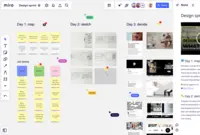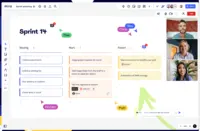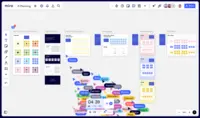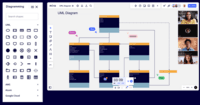Overview
What is Miro?
Miro provides a visual workspace for innovation that enables distributed teams of any size to dream, design, and build the future together. Today, Miro counts more than 60 million users in 200,000 organizations who use Miro to improve product development…
Miro: If you're not already using it you're missing out
Love using Miro to showcase my creative strategy!
Miro: Enabling inclusivity and productivity
The best collaborative tool
Miro review from a Industrial Sales Professional
Miro from LinkedIn DM
Great Collaborative product for large teams
Love it, keep pushing on polish
Hybrid Workplace Essential!
Great tool for those who love whiteboards
Miro is a great tool for project management and collaboration.
Miro Experience
Miro-aculous. Creating an in person experience in a remote world with Miro.
Miro is the perfect tool for companies that need asynchronous and visually pleasing communication
TrustRadius Insights
Awards
Products that are considered exceptional by their customers based on a variety of criteria win TrustRadius awards. Learn more about the types of TrustRadius awards to make the best purchase decision. More about TrustRadius Awards
Reviewer Pros & Cons
Video Reviews
3 videos
Pricing
1. Free - To discover what Miro can do. Always free
$0
2. Starter - Unlimited and private boards with essential features
$8
3. Business - Scales collaboration with advanced features and security
$16
Entry-level set up fee?
- Setup fee optionalOptional
Offerings
- Free Trial
- Free/Freemium Version
- Premium Consulting/Integration Services
Starting price (does not include set up fee)
- $10 per month per user
Product Details
- About
- Integrations
- Competitors
- Tech Details
- Downloadables
- FAQs
What is Miro?
Miro provides a visual workspace for innovation that enables distributed teams of any size to dream, design, and build the future together. Miro is used to improve product development collaboration, to speed up time to market, and to make sure that new products and services deliver on customer needs.
Miro's visual workspace enables distributed teams to come together to synthesize information, develop strategy, design products and services, and manage processes all throughout the innovation lifecycle.
A Miro board displays hundreds of collaborators moving through the space as named cursors on the screen designing, contributing ideas, providing feedback, and co-creating together with shared tools and information.
To learn more, please visit https://miro.com
Miro Features
- Supported: Drawing
- Supported: Marker Colors
- Supported: Mind Mapping
- Supported: Templates
- Supported: Drag-and-Drop
- Supported: Voting
- Supported: Commenting
- Supported: CMS Integrations
- Supported: Sharing
- Supported: In-Browser
- Supported: Desktop App
- Supported: Mobile App
- Supported: Collaborative Editing
- Supported: Task Management
- Supported: Notes and Comments
- Supported: Styles and Themes
- Supported: Image Import
- Supported: Custom Icons
- Supported: File Formats
- Supported: Cloud Storage Integration
- Supported: Mobile Application
- Supported: Desktop Availability
- Supported: Status Updates
- Supported: Instant Messaging
- Supported: Activity Feed
- Supported: Notifications
- Supported: Comments and Voting
- Supported: Discussions
- Supported: User Directory
- Supported: Online Status of Coworkers
- Supported: File Sharing
- Supported: Document Collaboration
- Supported: Version Control
- Supported: Tagging
- Supported: Knowledge Base
- Supported: Surveys
- Supported: Task Management
- Supported: Calendar
- Supported: Search
- Supported: Mobile
- Supported: Multi-Language Support
- Supported: Moderation
- Supported: User, Role, and Access Management
- Supported: Performance and Reliability
- Supported: Integrated Communications
- Supported: Native Communications
- Supported: Board Overview
- Supported: Screen Sharing
- Supported: Pre-made Templates
- Supported: Custom Templates
- Supported: Required Hardware
- Supported: Bring Your Own Device
- Supported: Permissions
- Supported: Talktrack
Miro Screenshots
Miro Videos
Miro Integrations
- Zoom Workplace
- Adobe XD
- Microsoft Teams
- Slack
- Dropbox
- Box
- Google Drive
- Zendesk Suite
- GitHub
- RingCentral Events
- BetterCloud
- monday.com
- Jira Software
- Azure DevOps Services
- Atlassian Confluence
- Trello
- HubSpot Marketing Hub
- Salesforce Sales Cloud
- Asana
- Webex Meetings
- Microsoft 365
- Google Workspace
- Giphy
- Figma
- Airtable
- Google Calendar
- Google Meet
- Notion
- dscout
Miro Competitors
Miro Technical Details
| Deployment Types | Software as a Service (SaaS), Cloud, or Web-Based |
|---|---|
| Operating Systems | Unspecified |
| Mobile Application | No |
| Supported Languages | English, French, Spanish, Japanese, German |
Miro Downloadables
- Miro is a workspace built for innovation. This download describes how Miro provides a full suite of capabilities for diagramming, wireframing, real-time data visualization, workshop facilitation, interactive presentations, and agile practices.
- About the business value of Miro per analysts at IDC This download describes what IDC analysts believe to be the Business Value of Miro.
Frequently Asked Questions
Comparisons
Compare with
Reviews and Ratings
(6831)Community Insights
- Business Problems Solved
- Pros
- Cons
Miro has been widely employed for various purposes, including brainstorming and facilitating team discussions. Its use extends to enhancing presentations with visual cues instead of traditional slides. The platform aids in efficient sprint planning and project management while aligning teams effectively. Users have harnessed its GenAI features for creating diagrams, compiling meeting notes, and conducting design tasks such as mapping user flows and journeys. Miro also serves as a crucial tool for customer research activities, from initial planning and note-taking to the final synthesis. Moreover, it caters to virtual collaboration needs by supporting design reviews, workshops with external customers, and fostering knowledge sharing within design teams.
Template Variety: Users have expressed appreciation for Miro's diverse range of template layouts tailored to different project needs, enhancing creativity and organization. The platform's extensive template options cater to various preferences and requirements, offering a wide selection to suit diverse project scopes and styles.
Real-time Collaboration: Reviewers have highlighted the platform's real-time engagement and updates as beneficial for fostering teamwork across different time zones, facilitating efficient collaboration and communication among team members. This feature ensures that all stakeholders stay updated with the latest developments promptly.
Effective Tools: Many users find the AI delete background tools effective for sketch uploads, significantly improving the overall user experience by simplifying tasks like image editing. The tool streamlines workflows and enhances productivity when working on visual content within the platform.
Performance Issues: Reviewers have frequently reported significant performance problems with large boards taking a long time to load, negatively impacting the user experience. This issue hampers productivity and frustrates users trying to work efficiently.
Limited Drawing Capabilities: Users find the drawing capabilities, especially for shapes, to be restrictive and have requested more variety in shapes and the ability to save brand colors. The current limitations hinder creativity and design flexibility on the platform.
Difficulty in Board Organization: Some users express confusion when organizing boards by department, struggling with determining the correct placement for new boards. This lack of clarity disrupts workflow efficiency and makes it challenging to maintain an organized workspace.
Attribute Ratings
- 9Likelihood to Renew98 ratings
- 8.8Availability8 ratings
- 8.8Performance7 ratings
- 8.1Usability72 ratings
- 6.4Support Rating27 ratings
- 9.7Online Training4 ratings
- 8.6Implementation Rating3295 ratings
- 9.8Configurability3 ratings
- 9Product Scalability8 ratings
- 7.4Ease of integration3639 ratings
- 8Vendor pre-sale1 rating
- 10Vendor post-sale1 rating
Reviews
(1-25 of 4555)Miro - collaborating efficiently
- Collaboration
- Presenting
- Meeting agenda
- One stop shop
- Integration with keynote, ability to import presentations
- More useful tool integrations
- A suped up Kanban chart feature with more abilities
We use it primarily for mind-mapping exercises, workflow brainstorming and illustration, and (as part of our agile process) decomposition of project goals into successively smaller chunks to identify Epics, Features, and Stories.
- Quickly and smoothly shifting around multiple components in an illustration without needing to "clean up" fiddly bits (e.g., connections being broken or whatnot)
- It might not seem like a large point, but the smoothness and fluidity of zooming in and out is a huge factor in not breaking focus
- Browsing for additional diagramming widgets for a given session is simple and intuitive
- The one aspect which kept the rating a "9" instead of a "10" is that I wish the general sense of fluidity and intuitiveness extended to being able to find previous diagrams. For some reason that's the one aspect which remains classically 'clunky'.
The best tools in these downstream contexts are niche products which incorporate context-specific constraints and guardrails.
- Allows me to visually show process work, quickly.
- Allows many others to participate (with minimal learning curve).
- Allows non-creatives to contribute in engaging ways.
- Text tool variations could be improved/streamlined.
- I wish there were more built-in/on-screen tools (with a customizable toolbar for new Miro users).
- More templates.
Miro: Enabling inclusivity and productivity
- Provides a board for idea sharing that mimics the face-to-face experience
- Enables Wide Open Whiteboarding (WOW) and Design Thinking
- Exports information shared into spreadsheet format for analysis
- The Windows app times out too quickly, causing numerous re-logins to have to be completed in a day
- Need more capability to use images without having to leave the app (kind of like Word does)
- Flexibility for things like the timer, post-its, boxes, etc. to be moved on the screen, perhaps working across multiple screens.
The best collaborative tool
- Collaboration
- Templates
- Talktrack, for recordings
- Could improve on the charts feature can be better
Miro review from a Industrial Sales Professional
- Mind maps
- Organize information
- Combine images with information
- Easier way to create slide deck
- Options for panning, left click is more natural
- Integrate with OneNote and other Office tools
Miro from LinkedIn DM
- Provides sharing options like permissions, starting view, an visibility to customize the experience
- Visual icons for major functionality
- Mirrored availability across web, app, and mobile
- Linked objects (grouped or linked with an arrow) don't have a meta relationship that you can take actions on, i.e. trace an arrow, edit a group
- Export to Excel, Paste to Excel still requires a transformation at the destination
Great Collaborative product for large teams
- Collaboration with remote teams around the world
- Vast work space for large and complex projects
- duplication and template usage
- track changes
- file integration
- speed and responsiveness
- storage and file structure for retrieval
Love it, keep pushing on polish
- Live collaboration
- Low complexity
- The auto detection of whether using a mouse or trackpad does not work well for me. I often have both connected at the same time and might switch which one I’m using and it doesn’t pick up which one I’m using at the moment.
- I would love to have cursor chat like in FigJam
- Would be awesome to have higher resolution or vector based emoji. The canvas environment encourages you to make emoji large, but they are designed to be text sized so the resolution shows quickly.
Hybrid Workplace Essential!
- Collaboration in a hybrid world
- Cross-functional workshops
- Templates
- Built in features for running trainings/pre-reads (ie. pre-recording board walk throughs)
- Simple 'guest' access when running workshops
- Continue growing template library, we love them
Great tool for those who love whiteboards
- Brainstorming and iteration
- Process documentation
- Meeting Facilitation
- adding shapes to a process map that spans more than one swimlane (Miro automatically adjusts my swimlanes and I don't want that)
- It enhances productivity by boosting collaboration and visualization.
- It improves thinking and customer mapping and handles virtual meetings well.
- Its flexible web templates allow for spontaneous brainstorming and mind mapping.
- Inconsistent search feature.
- And if more than 80 people join the meeting, it may slow down. But that many people is very unlikely.
- Large boards can also sometimes slow down your connection.
Miro Experience
- Bring in templates for use. Quick and easy exploration + drag in.
- Creation of frames, text, and stickies. These are the main tools my team utilizes for data analysis. (We prototype else where)
- Showing where teammates are and what they are looking at or working on.
- Color palette is buried and difficult to use. Tends to lead me away from prototyping in Miro.
- Load times of boards can take a while.
- Security with sensitive information.
- Add people to a workspace/team can be confusing and lead to people creating things where they shouldn't.
- How might we incorporate more emerging tech?
- Collaboration across teams.
- Organizing disparate materials in one single place.
- Creating a touchstone for point in time thinking and showing the evolution of that over time.
- Diagramming features are clunky and lack aesthetics.
- Integrations to some external platforms like Jira could be improved upon.
- Slack integration could offer more useful features.
Miro is the perfect tool for companies that need asynchronous and visually pleasing communication
- building user journeys
- brainstorms
- team work
- presentations
- presentations
- presentations
- Customer Journey Map formatting
- Prioritization exercises
- Collaboration during brainstorms
- Snap to grid function
- Auto resizing function to make elements match
- AI integration for meeting notes
Miro Whiteboard Tool
- Simple controls that are easy to get started with
- Infinite canvas
- Use of frames
- Ability to show/hide content
- Restricting the ability for participants to unintentionally manipulate parts of the board that are meant to be static
- Integration with PowerPoint
- Layers within frames
Miro totally saved my life in COVID
When COVID hit, I really worried about my ability to run large form workshops and qualitative interviews. With Miro, not only could I do all of that from home (mostly), but I already had all of my work digitized and ready for synthesis--immediately after the meeting. It's magic. A research run used to be measured by time in the field = time in synthesis (so, 1 week in the field, 1 week in a room). Now, with Miro, I can cut the synthesis time in half, and get to insights much faster.
Anyway, there are few tools that I'd actually rave about, but Miro is actually one of the key things in my quiver.
- Inclusive ways of engaging customers
- Restrictive design that let's me focus on the problem
- Super easy to learn and train folks to learn
- The music is terrible (I never use it, and the feature is sorta broken)
- Advanced ways of creating shapes would be nice
- Rasier access to the ai tools would be lovely
- Distributing objects that have joins (arrows) is not as easy as it could be
My use of Miro
- Easy to put together component diagrams
- Easy to collaborate with others as multiple people can look at the same thing
- Can add a lot of content
- Frames is good to encapsulate related data
- The zoom is super confusing. Different people draw diagrams at different zooms. For few days, I thought 100% should be default. But text at zoom 100% is too small. So I need to zoom in whenever I need to add text.
- If we have to look back after a long time, Confluence seems better as there are lot of explanations and a specific flow from top to botton. In Miro, it is hard to follow as we don't know where to start and where to end for big boards. Frames can provide some structure, but no one uses it for that.
- The board can be put at many places in the tree. It is hard to find it later.
- Visual collaboration on diagrams, charts, and other visual content in real time.
- It facilitates design thinking workshops.
- Roadmaps and timelines planning.
- Improve the mobile app to offer a smoother and more intuitive user experience.
- Expand the library of templates for different use cases and industry-specific cases.
- An offline mode that allows users to access and work on boards even when they don't have an internet connection, with changes syncing once they reconnect.
Miro Review
- Great for organizing and visualizing information
- It's easy to collaborate with others
- Very flexible tool when designing
- Check boxes from wireframe library are buggy
- loading time can be slow, especially for large boards
- More options for the background color of a board
Miro is amazing
- Design thinking templates
- Cross-functional collaboration
- Facilitation
- Easier exporting
- Single sign-on complexity
I would not use it as an individual trying to capture notes.
Miro is a MUST if you have a remote team.
The templates are a great jumping off point for newbies, but more often than not, we wind up just using some stickies and some basic shapes and we're off and running. The ability to recreate a genuine work session while not being physically in the same room is something we have not found with any other software.
- Co-working: the ability to tag in colleagues at exact points of the screen, or have them follow your cursor so they don't get lost.
- Customization: the ability to change colors, sizes, and details so you can mark things up individually and know what's what when you go back to it.
- Commenting: the ability to leave comments and tag others to those comments. This is becoming increasingly standard these days, but Miro was an early adopter, and it's made a big difference when our team is working asynchronously.
- Templates: feeling like you don't know where to start? Pull up the myriad of template options and start clicking around. It's sure to get your brain going.
- I'd like it to be easier to export frames and maintain quality.
- More shapes!
- More sticky colors. (Is this silly? Yes. But it would be helpful when working with a big team and a lot of topics.)
If team members are not game to learn new tech, it's a harder sell. There IS a learning curve, but it's VERY figure-outable. The willingness has to be there, though.
Miro works to put your mind on screen and build a plan!
- Result chains
- Process documentation
- Applying thought to screen
- Works with the Jira tool
- My needs have not outgrown Miro, and it does everything I need it to do very well
Works Perfectly for IT Workload Management
- Easy to use for my team, they don't waste cycles how to do this or that.
- Graphically represent what is needed, in progress and completed.
- The out-of-the-box templates are very helpful and helps me get a headstart.
- Provides a better picture regarding any projects we manage through Miro. All stakeholders can easily see it, what has been accomplished, what's next and where the challenges are.
- Better navigation with a touchpad. I use a mouse, but some of time prefer the touchpad, and being able to navigate a large Miro can get cumbersome. The nav map helps, but perhaps make it larger.












